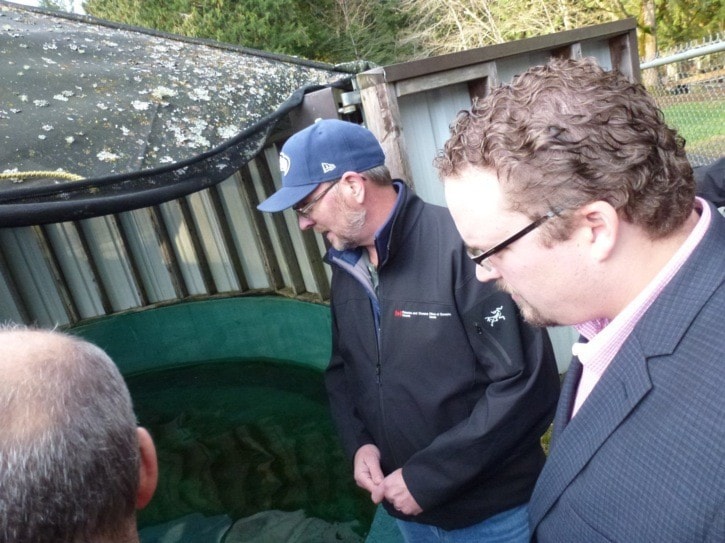Cultus Lake sockeye salmon appeared in fairly strong strong numbers this fall as they fought their way back from the ocean to spawn in Cultus Lake.
About 3,500 of the late-run sockeye made it this year to the Cultus Lake counting fence on Sweltzer Creek, which is downstream from the lake.
"All of the returning fish this year have been healthy and of extremely high quality," said Keri Bener, Fraser River sockeye stock assessment head for DFO.
Numbers of the genetically distinct lake-spawning sockeye have more than doubled from four years ago.
It's an indication the population is "stabilizing" according to the federal scientists at the lab, which has been studying them for decades.
Chilliwack-Fraser Canyon MP Mark Strahl and Randy Kamp, Parliamentary Secretary to Fisheries Minister Gail Shea were on a tour of the facilities Friday afternoon to see taxpayer-funded science at work at the Cultus Lake Salmon Research Lab.
About 200 of the 3,500 genetically distinct sockeye were taken this year for the captive brood stock purposes, to continue multi-pronged efforts to boost the fragile Cultus population.
"We're not just trying to flood the system with hatchery fish, but to supplement the natural population," said Stu Barnetson, watershed enhancement manager for projects at Inch, Pitt and Cultus Lakes.
"It shows we're going in the right direction."
Those intensive hatchery enhancement efforts were part of the DFO plan of attack after 2004 saw only 90 Cultus sockeye returning. They also looked at pre-spawn mortality, habitat issues, predator removal, and stock assessment.
They effectively created "a living gene bank" with the captive sockeye brood stock, said Barnetson, and could later release fry and smolts to help with restoration.
"This program gives great hope to a stock that had declined to less than a hundred adults about a decade ago," said Strahl.
The local MP appreciated the behind the scenes look at the salmon work, on his first ever visit to the DFO lab facility.
Lab staff were starting this season's collection of eggs and milt from the returning sockeye for incubation.
"I wanted to see the on-the-ground benefits, since there's been a significant investment made by our government in the Pacific salmon fishery," Strahl said.
It's a sockeye population that's actually been studied by scientists at the Cultus lab for almost a century.
A total of $26 million annually is spent by the federal government on the Salmon Enhancement Program.
"It was good to see federal government investment in actions to improve the returns of this endangered Fraser River sockeye stock. This is an example of how the department's day-to-day work is addressing some of Commissioner Cohen's recommendations," said MP and PS Randy Kamp.
Several branches within Fisheries including Salmonid Enhancement, Science Branch, Stock Assessment Division and Fisheries Management - have been working together on the rebuilding of Cultus Lake sockeye.
They initially tried adjusting the lake environment by attempting Eurasian milfoil removal and purse-seining and fishing the predatory Northern pikeminnow, but there was still some worry the Cultus sockeye would be eventually be extirpated, when numbers continued to go up and down.
Despite its unique status, Cultus sockeye never made it onto the federal Species at Risk list along with other endangered creatures, due to what were characterized at the time as "social and economic impacts," of closing commercial fisheries to protect it. The local fish didn't make the legally designated SARA list despite acquiring an emergency designation in 2002 as critically endangered by COSEWIC, and suffering high levels of pre-spawn mortality and over-exploitation.
So a range of other efforts were attempted.
"That led us to take the extraordinary measure of enhancement," said Jeffrey Lemieux, section head of Freshwater Ecosystems at the salmon lab.
There were better returns in recent years than those seen this year, however. In 2010, they saw about 10,000 sockeye return, and 7,000 came back the year after that.
